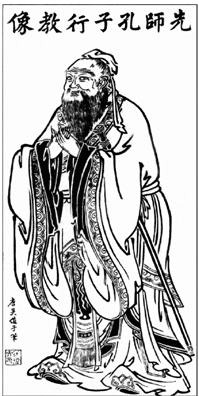Analects of Confucius
|
|

Analects (Simplified Chinese: 论语; Traditional Chinese: 論語; Pinyin: Lùn Yǔ, or Lún Yǔ as some might insist), also known as Analects of Confucius, is a record of speeches by Confucius and his disciples, as well as the discussions they held. Its Chinese title literally means "discussion over (Confucius') words".
Written during the Spring and Autumn Period through the Warring States Period (sometime between 479 BC and 221 BC), Analects is the most important work of Confucianism. It continues to have a huge influence on Chinese and East Asian thought and values today.
| Contents |
History and versions
Analects was written over a period of thirty to fifty years. Begun sometime during the Spring and Autumn Period, it was probably finished during the Warring States Period, though the exact publication date of the first complete Analects cannot be pinpointed. Similar to The Republic by Plato, Analects was penned and compiled by disciples and second-generation disciples of Confucius, albeit being mostly about Confucius himself.
The chapters in Analects are grouped by individual themes. However, the chapters are not arranged in any way so as to carry a continuous stream of thought or idea. In fact, the sequence of the chapters could be said to be completely random, with the themes of adjacent chapters unrelated to each other at all.
Moreover, certain vital themes keep resurfacing in different chapters, sometimes in exactly the same wording and sometimes with small variations. This further proves that the book was not written by one person but, like the Bible, was the collective effort of many. However, the final editors of the Analects were likely disciples of Zengzi (曾子), who was one of the most established students of Confucius.
When it came to the Han Dynasty, there existed three versions of Analects – Lu Analects (鲁论语), Qi Analects (齐论语) and Ancient Text Analects (古文论语). Lu Analects and Qi Analects were mostly similar, but Qi Analects had two extra chapters – Question the King (问王) and Know (知道) – on top of the twenty both versions shared. On the other hand, the Ancient Text version divided the chapter Zizhang (子张) into two chapters, and therefore had twenty-one chapters. Its arrangement of chapters and text were also different from the former two versions to a large extent.
Towards the late Western Han Dynasty, Zhang Yu (张禹), who was a teacher of Emperor Cheng, combined the Lu and Qi versions of Analects but kept to the number of chapters in the Lu Analects. Zhang's version then came to be known as the Marquis Zhang Analects, which is largely the version as we know it today.
Influence and significance
Since Confucius' time, Analects has heavily influenced the philosophy and moral values of China and later other East Asian countries as well. Together with the other three volumes of the Four Books, it taught the basic Confucian values including propriety (礼), righteousness (义), loyalty (忠) and filial piety (孝), all centered about the central thought of Confucius – humanity (仁).
Exam_cells-large.jpg
For almost two thousand years, Analects had also been the fundamental course of study for any Chinese scholar, for a man was not considered morally upright or enlightened if he did not study Confucius' works. The imperial examination, started in the Jin Dynasty and eventually abolished with the founding of the Republic of China, emphasized Confucian studies and expected candidates to quote and apply the words of Confucius in their essays.
Analects has also been translated into English, most notably by Arthur Waley and Charles Muller, and various other languages.
A particular point of interest lies in Chapter X of the book, which contains detailed descriptions of Confucius' behaviors in various daily activities. This has been pointed at by Voltaire and Ezra Pound to show how much Confucius was a mere human. Simon Leys, who recently translated Analects into French and English, said that the book may well have been the first in human history to describe the life of a man.
See also
External links
- English Translation of the Analects by Charles Muller (http://www.hm.tyg.jp/~acmuller/contao/analects.html)
- Multilingual edition of the Analects in Chinese, English and French (http://afpc.asso.fr/wengu/wg/wengu.php?l=Lunyu)
- An English Translation from the University of Adelaide Library (http://etext.library.adelaide.edu.au/c/confucius/c748a/)de:Analekte des Konfuzius
es:Analectas de Confucio ja:論語 ko:논어 pt:Analectos de Confúcio zh:论语
